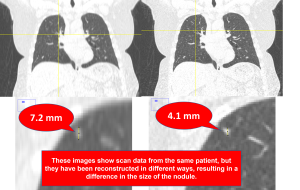The clinical variability of computed tomography (CT) scans can add to the radiologist’s load by demanding extra time and mental energy. RadUnity Corp., a UW spin-off led by Timothy Szczykutowicz, PhD, aims to address that problem, by developing and implementing a system for harmonizing medical images. On July 7, a Madison Startups article reported that the company had secured $500,000 in seed funding.
“The idea for RadUnity came from work I was doing for our clinic,” says Dr. Szczykutowicz, the start-up’s founder. “I found myself spending too much time and energy creating uniformity in our CT protocols across scanners located throughout the UW system.”
Every center – and sometimes, every CT scanner – has different image reconstruction settings, creating an enormous amount of variation. Oftentimes, a radiologist must decipher the image they are looking at before they can interpret the clinical data it contains.

Dr. Szczykutowicz realized that the image reconstruction settings can be centrally managed and reformatted using a single image from each CT scanner.
This workflow allows a radiologist to define a new type of image in one place, and have it instantly applied to any study they read. For example, if a radiologist desires to receive 10 mm MIPs of the chest for all indications over the thorax, this can be programmed in a few minutes. Without RadUnity, it would take hours to program onto the individual protocols and scanners within a single hospital. That same protocol change can be applied to outside studies, too, so radiologists using RadUnity control what they read from outside studies.
He validated the idea with some clinical cases and filed a patent with the Wisconsin Alumni Research Foundation (WARF). The patent, “System for harmonizing medical image presentation,” was awarded in 2019.
RadUnity’s software-as-a-service (SaaS) platform ensures a consistent “look and feel” for imaging data for a single patient over time and from patient to patient. This approach has been estimated to reduce the amount of time radiologists spend “hanging” a study by four times.
With the seed investment of $500K in place, Dr. Szczykutowicz is focused next steps: building a minimum viable product – a product with enough features to validate the idea – and getting regulatory approval. Once the FDA approves the technology, it’ll be able to be applied at scale.
“Outside studies should not be a burden to read,” says Dr. Szczykutowicz. “I want to see a day where radiologists can’t tell where a study came from.”
He hopes, too, to free technologists from workflows that are scanner-dependent. By creating a “load balancing function” that is uniform across a site, a busy ED technologist can focus on their patient, with image reformatting and processing automated or performed by another colleague in an outpatient clinic.
“I am thrilled to move forward with FDA-compliant product development,” Dr. Szczykutowicz said in a statement. “The fact that one of our investors is a former radiologist validates RadUnity’s potential to alleviate burnout and reduce time spent on image interpretations.”